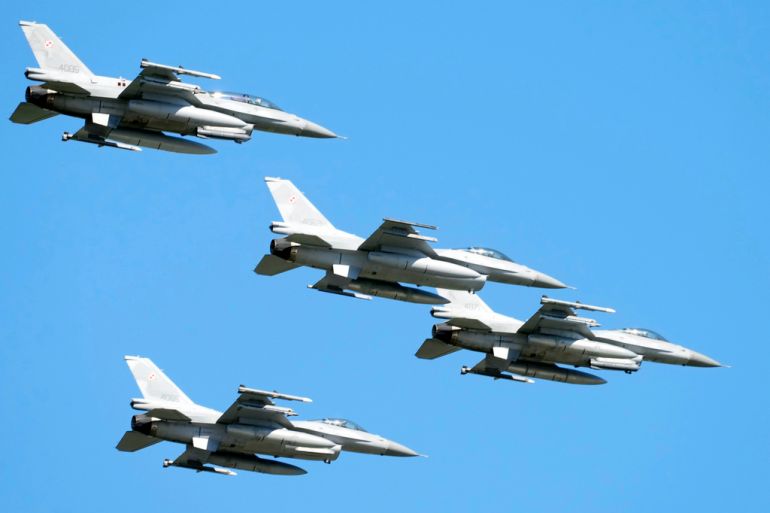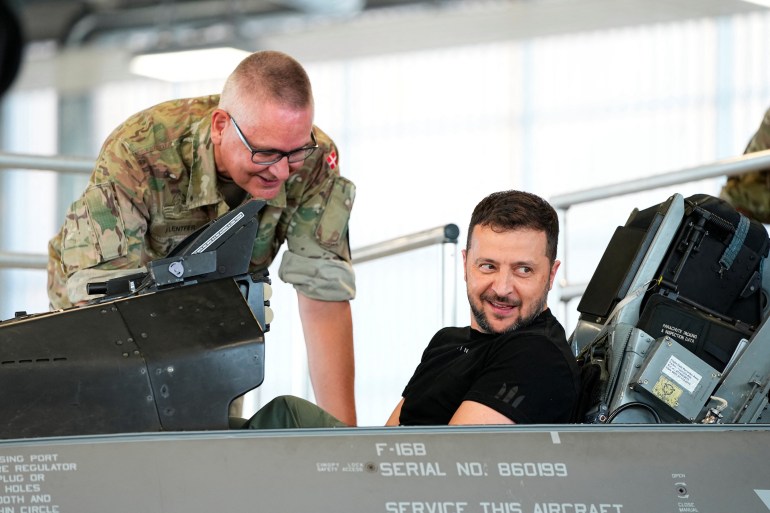How useful will the F-16s be in helping Ukraine?
Ukraine is increasingly looking to replace its jets as Russia continues to dominate the skies in the two countries’ 18-month-long war.

Ukraine’s President Volodymyr Zelenskyy has intensely lobbied Western militaries for fourth-generation aircraft like the F-16 that the latter have begun to shed.
After 18 months of war, Ukraine’s air force is badly in need of replacement aircraft as losses mount and Russia’s air force increasingly controls the skies above Ukraine.
Keep reading
list of 3 itemsGreece to train Ukrainian pilots to fly F-16 jet fighters, Zelenskyy says
Ukraine ‘sky shield getting stronger’ as allies supply coveted F-16s
Pros of F-16 fighter jets
Introduced in 1978, the F-16 has a great service record and variants have been regularly upgraded with better avionics, radar and weapons.
The jet is capable of performing many functions including ground attacks, electronic warfare, close air support, and air dominance.
It has been proven time and again to be a very capable fighter jet: Highly manoeuvrable, it can operate in all weathers, day or night.
The F-16’s adaptability means it can quickly be tasked with a variety of different missions, effortlessly able to carry out a new given role. It is this flexibility that has made it a mainstay of so many of the world’s air forces.

Cons of F-16s
While there are many pros to the F-16, there are also significant drawbacks.
Advanced Russian aircraft like the Sukhoi Su-35 have better radar and longer-range missiles. They would, in theory, be able to detect an F-16 and destroy it before the pilot even realised the Russian jet was there.
Like all complex aircraft, the F-16 requires regular maintenance and cannot operate from improvised runways such as roads, something that Ukraine’s air force is finding increasingly useful for its surviving aircraft as Russia targets Ukrainian airfields, leaving many out of action.
Few Ukrainian pilots are fluent enough in English to successfully pass the intense training programme needed to effectively fly the F-16.
In addition, ground crews often make the difference between success and failure as well-trained crews can refuel and rearm an aircraft more quickly than their adversaries, allowing the aircraft to get back into the fight.
This is a key discipline that makes a significant difference in conflict, but the crews themselves would need to train and rehearse on a variety of unfamiliar Western systems, which would take months, possibly years, to master.
Hide-and-seek
Russia has used its large supply of long-range missiles to good effect, striking multiple airfields far behind the front lines in an effort to destroy the Ukrainian air force jets kept there.
To avoid destruction, Ukraine has built an extensive network of rudimentary runways spread across the country.
At these remote landing strips, jets can be refueled and refitted with weapons.
Running low on aircraft
The British Royal Air Force estimates that Ukraine has lost 68 aircraft since the war began – 22 percent of its inventory.
Transfers from neighbouring countries of old Soviet aircraft have partially plugged the gap, but fighter jets have often needed major overhauls before they are able to fly again.
Russia’s air force has taken advantage of its superiority in air defences and has been increasingly effective at stopping Ukrainian air attacks.
For every 15 Ukrainian aircraft, there are 100 Russian jets.
The Ukrainian army is currently fighting its way through extensive Russian defensive barriers in a southern counteroffensive that has seen a lot of fighting for little movement.
This has been made much harder by Ukraine’s forces not being able to launch air attacks and control the skies above them. Testimonies from Ukrainian soldiers on the ground indicate they are most afraid of large precision-guided bombs dropped by Russian aircraft with deadly effect.
An injection of several dozen versatile, capable jets would, in the long run, help Ukraine and allow it to take the initiative, launch air strikes and support group advances.
The F-16s will take months to arrive and will slowly trickle in. When they do turn up, these aircraft will need extensive ground crews to keep them in the air.
Yet another long global supply chain will be needed to keep Ukraine’s air force supplied with the spare parts and weapons needed for the jets to keep flying.
The aircraft may not arrive in time to make a difference in the current counteroffensive as Ukraine is forced to rely on long-range missile and drone strikes to destroy targets far behind the front lines.